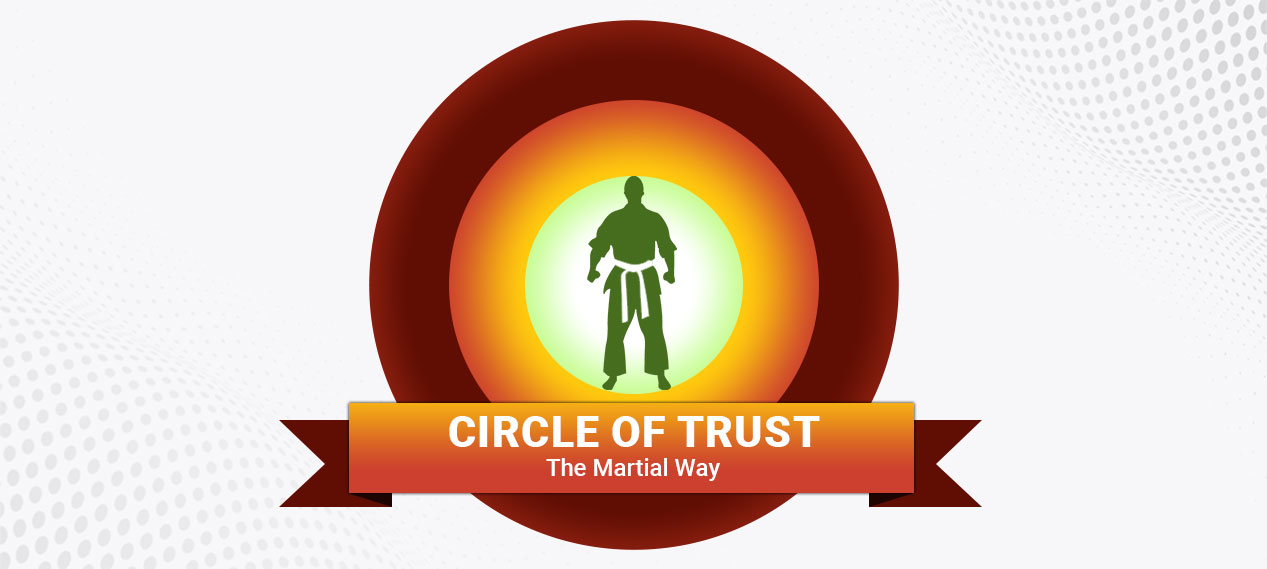
Circle of Trust – The Martial Way
September 05, 2022 Reading Time: 19 minutesLife offers us a great many choices, sometimes more than what we would ideally want, need or even like and with that, we are constantly tested on our capability to make sound decisions.
Imagine the scenario where your doorbell rings at the least expected hour. It’s a house call from, say, the maintenance guy that needs to ascertain if your water supply is fit for use. Would you let the crew in? Maybe, but not before you do the necessary diligence and verification of credentials at your end. On the other hand, if it had been a close friend or family at the door, you would and most likely, not subject them to scrutiny before letting them in.
The pivotal factor that comes into play here is “trust”.
Merriam Webster defines trust as – “assured reliance on the character, ability, strength, or truth of someone or something”. Although we define trust as an elemental force, it has numerous levels. Come to think of it, why else would you let one in your home no-questions asked, while for another you exercise caution!
Assessing trust levels is tough, given that it cannot be expressed or shared with mere words. For instance, say you know a person and for purposes of this discussion, let’s just call him John. How well do you think you know John? Let’s think a little more…
- Do you trust John?
- How much do you trust John?
- How do you decide how much trust you can place in John?
Our interactions and exchanges with John will vary in the degrees of engagement and commitment depending on the level of trust we can place in him.
What has led me to write about this?
Let me attempt to explain through one of my most important life experiences.
I guess, I need to go further back to develop some context here. Many of us may have experienced conflicts during our early years at school and much like a rite of passage, it wasn’t that uncommon to encounter incidents of bullying or minor conflicts during those formative years. I too have had my share of the same and inspired by Bruce Lee and Jackie Chan, my younger self saw the solution in training for Martial arts as a means to build confidence and defend myself!
Note: Oh yeah, Jackie Chan and Bruce Lee were at their peak and inspirational. Some old time hits I’d recommend are here for you: The 36th Chamber of Shaolin starring Gordon Liu, Enter the Dragon starring Bruce Lee, Drunken Master starring Jackie Chan.
Well, this started my journey into the martial world. I started my training in Kyokushin karate, the strongest form of karate that exists. Somehow, I knew that this would be the solution that would stick with me long term. As I progressed, life changes ended up taking me to different places bringing on a new set of challenges. For one, to continue my journey into martial arts, I had to find a training center closer to where I was stationed. It wasn’t always easy for me to find a new dojo or training center but this problem soon turned into an opportunity as it led me to subsequently train in different styles of martial art forms – Norther Shaolin Kung Fu, Wushu, Hapkido, Taekwondo and finally Haidong Gumdo which I am training in at the time of this writing.
All of this may have started as a mechanism of self-defense, perhaps with a sprinkling of some element of violence or revenge as the preliminary objective of training, but soon somewhere inside of me, without my complete awareness, a transformation had begun to take place, and a realization had started to grow. Over time, I connected with the spiritual side of martial arts and its teachings and they guide me to-date to understand the essence of self-control and respect as I journey through life.
While it would be near to impossible to condense 20+ years of learnings in a few words, there are important takeaways from my training that I am happy to share. And, ironically, repeatedly, I was taught to retreat and avoid conflicts, much in contrast to the glorious idea of martial arts that my younger self had once nurtured.
The Learnings….
So, what was my training all about when retreating or pulling back became the final outcome? The full contact sparring sessions I underwent as part of my learning, pitched me into near life simulation to actual confrontations and it was only after years of practicing that the true nature of the martial arts training gradually began to sink in. I learnt:
- Key vulnerable areas of human anatomy; one targeted strike has the potential to be lethal.
The lesson – self-control, assess my opponent and understand my own defense radius.
- What pain really means when struck and being severely injured.
The lesson – proactively understand the result of striking an opponent and the damage one can inflict.
- What it means to fall and almost want to give up, and yet muster up the strength to finish the round.
The lesson – do not give up but persevere.
- Walk away or retreat from confrontations.
The lesson – avoid conflict and engage in combat only as the last resort.
- And many more…
As you can see, I have imbibed the philosophy and the guiding principles of martial arts in my work and personal life in a manner that has been extremely rewarding, to say the least. This has helped me make better choices where it mattered the most and take grounded decisions in my personal life.
Furthermore, I realized that this approach has had a direct impact on my decision-making and leadership style in business. My training has had a tremendous influence on the way I perceive situations and exercise self-control and self-discipline – these two being the pillars of my core principles or values. In retrospect, my training has added to my core values and helped to develop and strengthen it further.
Simply speaking, our core principles define who we are and are completely intrinsic to each one of us. It is the core values or principles that dictate our work ethics, family bond and social interactions.
And where do these core principles or values come from?
Well, these core values stem from the value system we are brought up in and forms the kernel of our existence. Our life experiences unambiguously add on to it, shaping our true selves. Our core values play a vital role as we build a circle around us with our families, colleagues, partners, friends, acquaintances and to some extent, even strangers. Our interactions with each of them vary in degrees and affects the depth of the relationships we build or the exchanges we have.
Which brings us back to “trust”.
The Formation of the Framework.
Fundamental as trust is, life would become intolerable without it. At the same time, betrayals cut deep, cause enormous emotional distress, and can run financial losses, sometimes making it difficult to recover from such dire circumstances.
This really made me think. Is there a logical framework that can be used to conceptualize this ‘trust’ amongst our associations to make informed decisions and not having to always second guess or look over our shoulders? Is there a way to not be conflicted because we cannot completely trust the other side?
One thought led to another, and an idea began to take form – slowly – deriving its structure from my years in training in martial arts, my cultural values, my core principles and experience. And in time, I began formulating a concept of a trust framework. Before I present my concept, I would like to share a very interesting aspect of my martial arts training with you.
As I continued training through the years, I began establishing imaginary defense parameters that went around me in a perfect circle – a logic I borrowed from the simple geometric shape that we all know about. Yes, a circle – the quintessential 2D figure.
To explain it better – consider an imaginary circle with yourself at the center and its circumference being the maximum distance that your hands and legs can stretch in all directions. This circle marks your territory – a space sacred to you – where you are safe and comfortable. Would it be acceptable to you if anyone tries to breach into this circle? Definitely not! Now this tells you that you will be on your guard if anyone unknown to you attempts to cross the periphery of this circle, right?
And this is exactly what happens during a hand combat or sparring session – a common training method used in combat sports and especially in martial arts which encourages free form fighting within a defined set of strict rules and customs. While it is possible to sustain injuries during a sparring session (and I have sustained my share of those!), the objective of sparring is to enhance skills and develop fast reaction times. But more about that in a bit. For now, let me just explain the mindset I am in when in a sparring session.
So, there I am – at the center of my defense circle, on guard, alert and ready. Now this circle helps me sense how close my opponent/sparring partner needs to be in order to breach its boundary. And if and when they do cross into the circle, I am ready to counterattack and defend. How I plan to counter and what moves I need to make depend on the distance of my opponent from the boundary of my circle of defense.
With me so far? Great!
This basic combat strategy can be applied outside the training floor just the same. Isn’t it natural for you to defend your space? It’s not just me in a fight session, but I believe all of us have a circle around us which we like to protect much beyond the physical dimension. We protect our circle from harm, and we do it the best we know. As my concept began to take shape, I began to wonder how to design my framework, so it aptly justifies the complexities that trust, or its absence thereof brings into our behavior.
The Introduction of Circle of Trust – the Martial Way
Allow me to introduce – “Circle of Trust – the Martial Way” that I like to refer to – as a logical framework that conceptualizes trust and its complexities. Theoretically, this Circle of Trust framework consists of three main concentric circles – the Inner-Circle, the Mid-Circle and the Outer-Circle representing different levels of trust and each circle defining a trust region. Associated with each trust region is a set of behaviors or guidelines that aid in decision- making and puts safeguards in place for our interactions in that region.
The basic purpose of this framework is to help you with structured and organized interactions and to caution you against entering into transactions that do not conform to the guidelines. To understand the concept better, let us take a closer look at each of the circles and the behavioral guidelines associated with each of them.
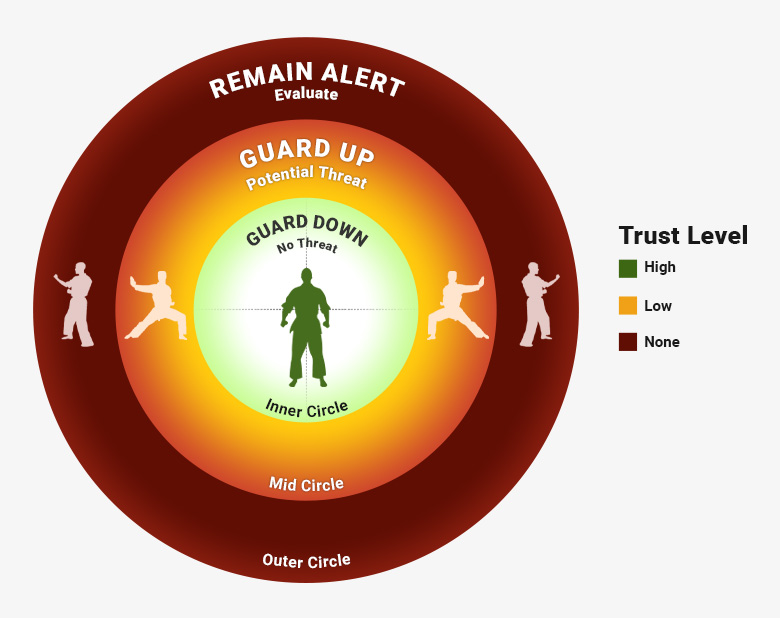
The picture above depicts the entire framework in a single diagram, showcasing all the various regions. I’ll explain the trust regions in more details below.
The Inner Circle – The First Circle of Trust
You can let your guard down. You will not be stabbed in the back but will be protected by those around you and you would do the same for them!
The takeaway in this region is depicted below diagrammatically.
- Threat Level: None
- Trust Level: High
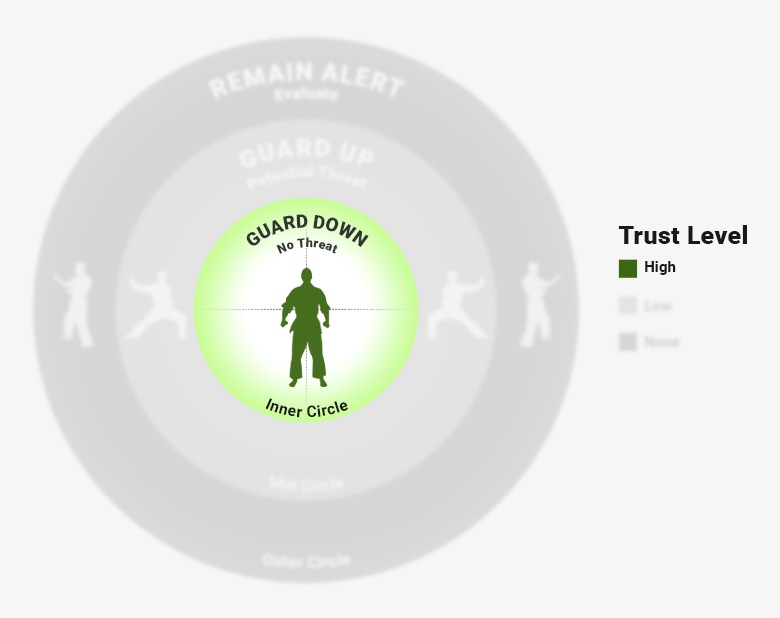
The Martial Way: This is the first circle – the innermost circle, the most important one and the closest region around you. As I have explained above, when facing an opponent, I would guard this inner circle with all my might. I will be extremely cautious of unknown people attempting to get into this zone. Wouldn’t you?
On the other hand, the people you let into this circle are the ones you can trust. Usually, you’ll hear not to ever let your guard down. However, in my experience, I believe that when you have trusted ones around you, you cannot keep your guard up as it will create a sense of insecurity in them with respect to you. Allow me to explain this. When training in Haidong Gumdo, we carry our swords at all times. At the end of every class, it is customary that we shake hands and bow to the grand master and to our peers. As a general rule, when we approach the grand master or anyone else in our class, we hold our sword in front of us parallel to the ground with the blade pointed inwards toward us. While one hand holds the sword, the other hand is extended out to shake hands as we bow to the instructor or to each other. This is not only a sign of respect and of submission, but it is also about surrendering yourself. It sends a clear message of respect and mutual trust, and your stance is much more relaxed as you are not on guard. This is what the Inner Circle is about – where you can let your guard down for the ones you trust the most. Now imagine if I approach to bow or shake hands while I appear to be on guard and ready to use my sword – how do you think that would be received? I believe you can imagine the perception and the outcome of such an act.
Similarly, in life, this Inner Circle is an extension of the self, and it constitutes the most trusted ones in our lives. In all likelihood, your family, close friends, advisors make up this Inner Circle. Your interactions with them are easier, transparent, informal because the trust levels are significantly higher. At the same time, the likelihood of any betrayal is very low!
Extend this out to business and you will quickly start seeing the connections. Your Inner Circle should comprise of those with whom you share an extraordinary level of trust. “Handshake deals” are a common phenomenon here as is sharing of confidential information. Financial exchanges in the Inner Circle are based on mutual trust and more often than not come with a guarantee.
Our positive life experiences with people guide us to, generally, let our guard down and allow them to gradually enter this Inner Circle. Generally, this inner circle comprises of people with whom you have successfully built a strong bond with over a period and are likely to stick together through thick and thin.
Now, for a moment, sit back and imagine how many within your network would fall in this region – your Inner most Circle.
The Mid Circle – The Second Circle of Trust: Potential Threat
Get your guard up, you could be in for a surprise!
The takeaway in this region is depicted below diagrammatically.
- Threat Level: Potential Threat (Mid-Level)
- Trust Level: Low
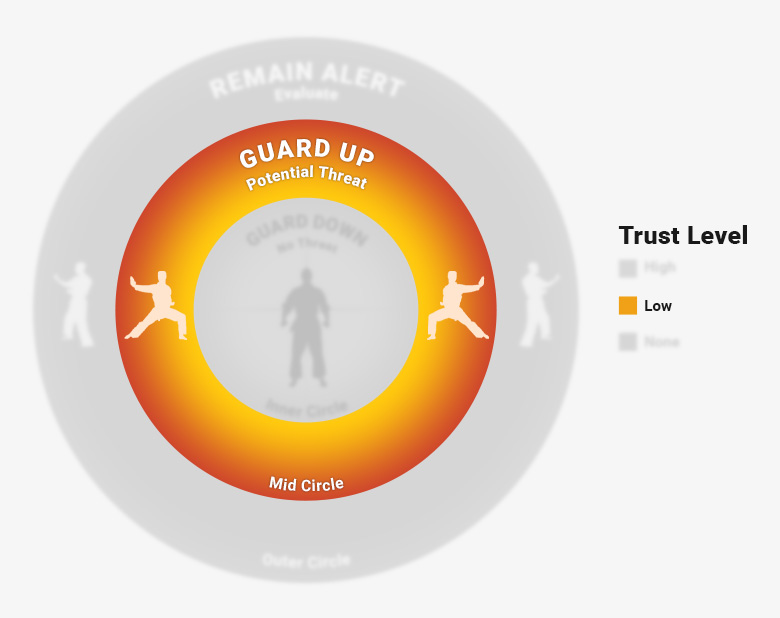
The Martial Way: The Mid-Circle is the region right outside the periphery of the Inner Circle. This is the region where your opponent waits for an opportune moment to strike, and you must be on guard for any incoming punches or kicks directed your way. If you lose focus for a bit, you are increasing the chances of your opponent gaining an advantage resulting in some serious damage. And you do not want to be at the receiving end, do you?
Drawing the analogy to real-life situations, your guard is always up with people in the Mid-Circle trust region. Generally, the ones in this region are not perceived as a threat. However, trust levels are lower than that in the Inner Circle. Your relationships or collaborations with people in the Mid Circle do not usually go beyond a formal arrangement.
Your business decisions will require careful consideration and you will want to ensure that you are safeguarded by proper contracts. The mood in the Mid circle is not combative, it is simply about remaining clear of controversies, arguments, or disputes and being very careful at all times – remember, trust is comparatively low in this region.
Just so that we are clear, this by no means is a suggestion that you do not put safeguards in place for the Inner Circle. What I am talking about here is a mindset, a basic conceptual framework.
The Outer Circle – The Final Circle of Trust: Evaluate
Remain alert and conscious.
The takeaway in this region is depicted below diagrammatically.
- Threat Level: Remain Alert and Evaluate
- Trust Level: None
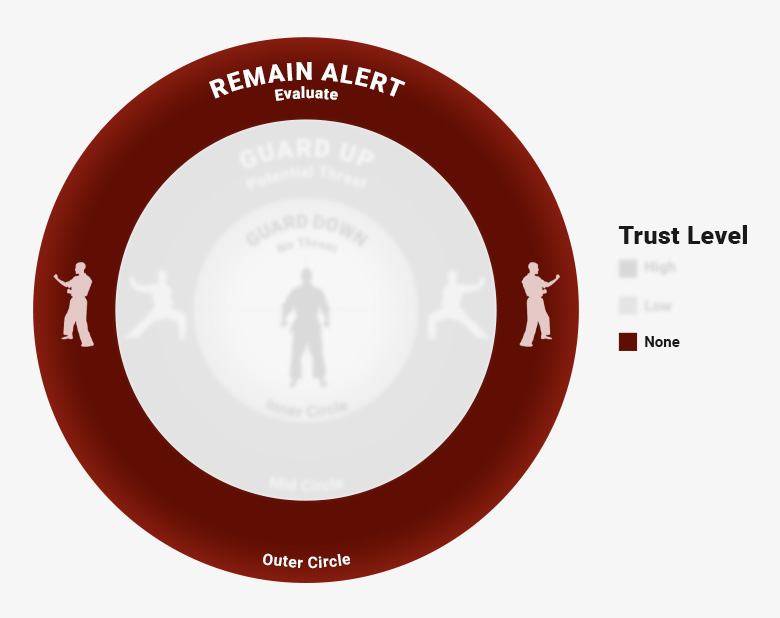
The Martial Way: To continue with the concept of sparring, we first need to understand what sparring is all about. [Sparring is a training technique in which fighters work on punches, footwork, and defense without actually fighting.] Although it allows contact fighting, sparring teaches a very basic and extremely important lesson – self-control. A sparring session is not a free ground where you can beat your opponent into submission nor is it a place to exact revenge for bruised egos, on the contrary, it is the place to learn to play just and exercise self-control.
Now consider the Outer Circle which is the third and final circle of trust. It is beyond the Mid Circle and too far away from the Inner Circle. Therefore, I would be unable to strike by simply extending my limbs. The only way to make contact would be to either get closer to the opponent or to lure him towards my Mid Circle. Therefore, I must choose to only exercise refrain or self-control.
The guidelines for this circle when extended to life are simple: refrain and be mindful. The Outer Circle is too far out for you to really be too concerned and there is almost little or no threat or interaction with people in this region. They could be strangers not related to you. Or someone who you’ve just met at random or been casually introduced to. Or, to put it mildly, those with whom you have not had a positive experience in the least bit. The last of the above lot are most likely going to remain in this region indefinitely. Because you would not be interested in letting people who have betrayed your trust in life get anywhere close to you again, right? They would remain in the Outer circle, and you would be careful in ever letting them get past this region. There is either no connection except for a very generic one or if a connection does exist, it is weak and has been severely damaged or is completely irreparable.
Now, let’s go back to the first two questions that we started with when we met John – do you trust John and how much? Imagine John to be someone you know and relate the experiences you have had with him. Imagine the three circles (the framework discussed above) around you and think for a moment – where would you place John? Now when you place him in any of the Circles – Inner, Mid or Outer, it will help you identify your level of trust in him almost immediately and subsequently define your interactions with him.
Now for the last question – how do you decide how much trust you can place in John? If you’ve never interacted with John, he will have to start at the Outer Circle. Gradually, as you build the relationship and learn through your interactions and engagements, you will ultimately be able to decide whether John will ever make it to your Inner Circle. If he does, he’s someone you will and can count on.
Do this exercise a few times with the people that you know and see how it works for you.
The Takeaway
There are several parallels that can be drawn from the philosophy of martial arts and each can help to drive important business decisions.
Any form of martial arts encompasses repeating a set of moves several times over. And the question that bothered me for a long time was just about that – why is it necessary to repeat the same sequence of movements over and over again? The logic behind the repetition is simply to build muscle memory and discipline.
In the same way, Circle of Trust is a trust-based framework that allows better assessment of situations and people we encounter in life. When this concept is applied whenever and wherever necessary, it begins to get ingrained and soon becomes a habit. As with everything else, you get better results with more practice.
When you conceptually categorize the people you know into the Circle of Trust Framework, you are simply making it easier to keep interactions devoid of conflict, communications clear, and the damage, if any, to a minimum. I have been able to test the success of this framework and, I feel, have built better relationships, or defined better engagement strategies in business. I trust you too would find the Circle of Trust Framework useful to distribute trust levels and make informed decisions in your life.
I’d love to hear your feedback.
Thank you!
Sachin
Below are some pictures and a video from my training in Haidong Gumdo.
Pictures: Snuffing the candle as a part of my training in Haidong Gumdo.

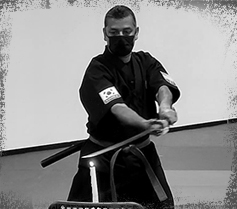
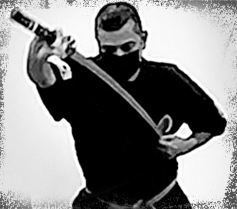
Video: Haidong Gumdo Demonstration – Cutting bamboo with precise moves.
 About the Author: Sachin Agrawal, serial entrepreneur, investor, business leader, technologist, enterprise architect, founder & CEO of Tarika Group has over 20+ years of experience in building enterprise solutions for small-mid size organizations and providing virtual CIO solutions to organizations catering to a wide portfolio of industries.
About the Author: Sachin Agrawal, serial entrepreneur, investor, business leader, technologist, enterprise architect, founder & CEO of Tarika Group has over 20+ years of experience in building enterprise solutions for small-mid size organizations and providing virtual CIO solutions to organizations catering to a wide portfolio of industries.
He has varied interests – from technology advisory and mentoring to making music on his guitar and is a certified scuba diver. A practitioner of martial arts, he is trained in Kyokushin Karate, Wushu, several other forms and holds a first-degree black belt in Haidong Gumdo – a Korean way of the sword.
You can connect with him here!
Tarika Group Inc., dba Tarika Technologies, is focused on delivering innovative business solutions through Management Consulting, Managed Service Provider (MSP), Enterprise Software Development and Digital Media Solutions.
For more information on Tarika, please visit www.tarikatechnologies.com.

